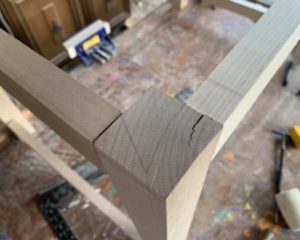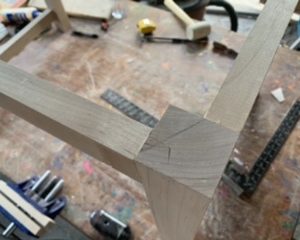I have a small table I just built to hold a soapstone sink. The sink is about 200 lbs. I cut the mortises with a 1/2 straight bit and rounded the tenons. When I was fitting the tenons, I discovered that the mortises were deeper on one edge than the other by a small margin which essentially made the mortise off square. I’m assuming this occurred because I didn’t keep the router square.
In any case, the legs sustained fissures when I joined the tenons to the mortises during the dry fit (shown in pictures). I was thinking of just getting some metal braces to reinforce the joint rather than messing with it too much. Any opinions on how that should work out? I figure the braces will be on the inside face and under the sink anyway, so no one will ever notice.

















Replies
Looks like your tenons were too tight. Also your mortise was likely too close to the top of the leg. It's wise to make your tenon deeper on that upper side (ie 3/8" or 1/2" shoulder on top and 1/4" bottom shoulder.
As for fix, rout the mortise right through the top of the leg then cut a piece to fill the gap and glue it in. You could also try to squeeze some glue in there and clamp it if you want to try a real quick fix.
Then trim your tenons. If they're off square like you say, that's a drag but if you've got a shoulder plane (or rabbetting plane) you should be able fix it up to fit without tooooo much trouble.
Just remember, your tenons should be snug but you shouldn't have to really ream them in. That might be okay in a mortise middle of the board somewhere but near the endgrain it's almost a guarantee that a tenons that's too fat will blow out.
I agree that the mortise is a bit too tight. Try to find the tight spots and shave them down so that the tenon has some resistance, but does not require a lot of force. Put a clamp across the split to hold it closed while you are doing this.
For a fix of the split: With the clamp off, put excess glue into the mortise when you are doing the final glue-up. When the tenon is pressed in, it should push the excess glue out into the split. Then put a clamp on it to hold the split closed until dry. This should result in a joint as strong as if the split was never there.
What Eideann said.
A tenon should fit with really hard hand pressure alone. You should have to squeeze like the dickens to get it in -- not too easy. But if you need a mallet or clamps, it's too tight.
Some folks will leave the part with the mortise extra long to avoid splitting during assembly, then trim after. You see this most frequently on doors. I usually don't bother.
With so much time in already, do a proper fix. If it was glued up already I could understand a patch, but at this stage there is nothing to stop you. Stay the course!
Thanks all. I’ll focus on sizing the tenons better. I had become a little too zealous with one tenon when I noticed the cracks occurring and shaved it down too much so that it had no more resistance on the shoulders. Luckily I have a little more spare material to redo that tenon.
I was worried also about the load the table might carry since the legs are just 2 x 1 7/8. I am now wondering if their purpose should not be to hold up the 200 lb sink I mentioned (and I should just demote this one to coffee table status).
I think it will be strong enough.
Racking would be the biggest concern IMO. You've got stretchers on the bottom so I think you're OK.
You might consider pinning the tenons.
Soapstone is heavy, and very subject to cracking.
Is this going to be open underneath, or enclosed? If it is enclosed, I would build a platform underneath for the bottom of the sink to sit on. Then the cabinet you show above is really just a decorative facade surrounding the sink.
It will be open underneath. I was going to maybe do a 3/4 or 5/4 top for it to sit on. The sink is 36 wide and 18 inches deep (to the wall) and the table is 36 wide but 24 inches deep (to the wall) so that the sink really sits at the front and extends back 18 inches (leaving 6 inches to the wall). I did it that way initially because the kitchen cabinets are 24 inches deep so I figured I should be the table the same depth. But then it occurred to me that part of the sinks load would not be evenly distributed towards the back. I thought maybe a middle support might be wise in that case. Though, if the top is rigid enough, I feel like it should be strong enough to distribute the load.
This forum post is now archived. Commenting has been disabled